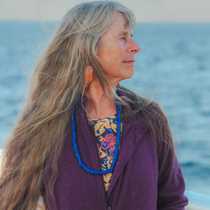Chichagof Island, Fox Creek & the Inian Islands
Early this morning the National Geographic Sea Lion was making her way into Idaho Inlet, located on the northwest corner of Chichagof Island. It was a grey on grey with shades of dark green morning, mist in the trees, clouds low in the sky and as we motored into the inlet several flotillas of Sea otters were spotted. Watching them, while they watched us, we observed the occasional and typical Sea otter pose of righteous indignation as we entered their territory.
As breakfast was being served, the National Geographic Sea Lion returned to the outside of Idaho Inlet where our officers and deck staff prepared for all our morning activities. Kayaking and hiking would be the interchangeable activities offered to everyone. As soon as all gear was brought ashore and preparations were complete, shuttles began to two separate beaches. Hikers were brought ashore at Fox Creek for several different lengths of hikes. Long hikers headed out into the forest and up into a blanket muskeg at a slightly higher elevation. Medium and leisure hikers enjoyed similar territory, but with more emphasis on entering what one staff member called the house of the bear.
Many sets of permanent bear footprints were found in the meadows just behind the shore and in the forest. Added to this was the presence of several scratching trees. It was also the beginning of the peak of wild flower season in Alaska. With nineteen hours of light per day the growing season is long and lovely at this northern latitude!
Approaching from the beach, a slight bushwhack of twenty yards led into the outer area of the forest; almost no contact with salt water, rich soil with much added nutrients coming from the Sitka alders, a nitrogen fixing tree common in Southeast Alaska. All around our feet was scattered the rich diversity brought about by these excellent growing conditions – a myriad of flowers. Wild strawberry, Nagoon berry, several orchid species one filling the air with a lovely scent, Yarrow, Chocolate or rice lily, Shooting stars, Wild violets, Silver leaf, buttercups, yellow Indian paintbrush, Beach Sweet pea, Cow parsnip and many grasses and sedges. It was hard to take a step without marveling at the intricate and beautiful display of wild flowers.
Inside the forest were the makings of a bear highway with many interwoven trails all created by Brown bears. Following their lead we entered a green world of many different levels of canopies that make up a temperate rain forest. The ground held many species of wild flowers, with the second canopy of shrubs, largely currant, salmon berry, huckleberry and Devil’s club. The upper story of the temperate forest was the trees, many Sitka spruce and Western hemlock. Everyone enjoyed moving through the forest and some of us made a slight climb up into two different blanket bogs just above the forest. Still on bear trials we found many a large print of a bear that had passed ahead of us moving through this well-known Brown bear habitat on Chichigaf Island.
Meanwhile the kayakers enjoyed their own brand of adventure exploring the waters around Shaw Island. Close encounters with humpbacks were enjoyed, and that rare moment to be quiet on the water seeing, hearing and being in this unique place in the world.
All too soon it was time to return to the National Geographic Sea Lion for lunch. While we enjoyed a much earned midday meal, our crew and officers repositioned our ship and gear for the afternoon’s activities. Moving back out into Icy Straits we cruised slightly north to the Hobbit Hole, and anchored just off of the Inian Islands.
This is the northern entrance where all the tidal waters of the Pacific Ocean enter and leave the web of islands that make up Southeast Alaska. So the tidal changes are enormous and can provide one of the most fabulous opportunities for Zodiac tours. Our afternoon was dedicated to two rounds of tours. Once we were away from the fantail of the National Geographic Sea Lion, we made our way a short distance towards a well-known haul out for Stellar Sea Lions. The time of our tours was perfect, beginning on the incoming tide that brought an enormous influx of seawater, creating tremendous currents and eddies. The incoming tide made available another critical resource, and that was the Pacific salmon. The Stellar sea lions were waiting and as we cruised by, these well-equipped hunters were harvesting salmon all around us. We watched as Sea lions lifted the large fish out of the water, flipped them in the air, until they broke up into more manageable bites and feasted. Gulls and Bald eagles hovered overhead picking up anything left over from these messy hunters.
There were several Humpback whales also working these incoming tidal waters, lunge feeding at the surface and one animal in particular was using the steep walls and deep waters to herd its fish against the rock wall while lunging through the water! A visual feast had been presented for all, mixed with the sounds of many birds, the sea lions and the blows of the whales all decorated in the afternoon light falling on the scenery of islands, mountains and sea.
Our day had been a gift of immersion in an intact ecosystem, one that has existed for thousands of years here in Southeast Alaska and is a rare experience in today’s world.




